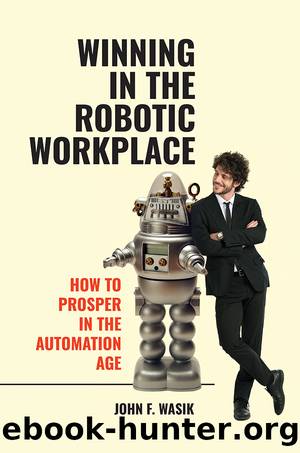Winning in the Robotic Workplace by John F. Wasik

Author:John F. Wasik
Language: eng
Format: epub
Publisher: ABC-CLIO
HOW WILL THE LIBERAL ARTS HELP US INTERFACE WITH MACHINES?
The intrusion of machines into labor is going to require a new mindset. You’ll not only need technical knowledge, but the openness to embrace new ways of thinking. That’s not easy for most people to do, especially as they cling to their biases and worldview. That’s where the liberal arts can open doors.
Leonardo, for example, not only saw himself as an artist, he was an anatomist, designer, and engineer. He was working on solutions to move water and make better weapons. Michelangelo was not only a painter and sculptor, he was an architect whose designs were incorporated into St. Peter’s Basilica in Rome. Even modern-day designers such as Frank Lloyd Wright and Frank Gehry infuse art into architecture. Wright’s trip to Japan and Germany profoundly influenced his aesthetic and “prairie style.”
What are the liberal arts, and why are they important? They are built on the foundation of openness to experience. “Individuals who are open to new experiences are more likely to make connections among seemingly unrelated pieces of information, as well as see new patterns,” notes Seligman.109
The definition of liberal arts goes back to the fourteenth century and was the foundation of academic learning. Derived from the Latin liber, meaning “free or unrestricted,” it was then (and now) a novel form of learning where you would explore new ideas in science, philosophy, the humanities, and mathematics.110 The core of liberal arts was what the Greeks and romans called the trivium, which was grammar, rhetoric, and logic (basically reading, writing, and philosophy). Over the years, this core curriculum expanded to the quadrivium, which added arithmetic, geometry, music, and astronomy.111 Of course, when the scientific revolution emerged in the sixteenth and seventeenth centuries, the liberal arts umbrella widened even more to include biology, chemistry, physics, and a multitude of spin-off science and technical realms such as electromagnetism, evolution, genetics, and thousands of subspecialties.
What makes the liberal arts unique is that while you’re building on past knowledge, you’re guided by philosophy and often allowed to break the rules and come up with new ones. You’re asking questions, not just learning an old set of rules. Contrast that with strictly professional regimens such as business, engineering, and law where often the rules of a profession may be sacrosanct. Liberal artists are more in the business of seeing the world in a newfangled way. They are trying to make sense of the world in their own fashion. There is no program that allows them to experience what Aristotle called phronesis, an “artful synthesis of both knowledge and experience,” Madsbjerg observes.112 This is the cornerstone of what I referred to earlier as synergistic creativity.
Culture and meaning, what Madsbjerg calls “thick data,” occupy center stage in a world in which human experience is more important than an obsession with technology. Creativity and “bottom up” inductive reasoning may help us even more. We need to interpret rather than blindly accept the changes around us. We question instead of passively consume.
Download
This site does not store any files on its server. We only index and link to content provided by other sites. Please contact the content providers to delete copyright contents if any and email us, we'll remove relevant links or contents immediately.
| Computer Vision & Pattern Recognition | Expert Systems |
| Intelligence & Semantics | Machine Theory |
| Natural Language Processing | Neural Networks |
Algorithms of the Intelligent Web by Haralambos Marmanis;Dmitry Babenko(7857)
Hadoop in Practice by Alex Holmes(5661)
Jquery UI in Action : Master the concepts Of Jquery UI: A Step By Step Approach by ANMOL GOYAL(5516)
Life 3.0: Being Human in the Age of Artificial Intelligence by Tegmark Max(4514)
Functional Programming in JavaScript by Mantyla Dan(3724)
The Age of Surveillance Capitalism by Shoshana Zuboff(3428)
Big Data Analysis with Python by Ivan Marin(3047)
Blockchain Basics by Daniel Drescher(2894)
The Rosie Effect by Graeme Simsion(2714)
WordPress Plugin Development Cookbook by Yannick Lefebvre(2613)
Hands-On Machine Learning for Algorithmic Trading by Stefan Jansen(2528)
Applied Predictive Modeling by Max Kuhn & Kjell Johnson(2485)
Test-Driven Development with Java by Alan Mellor(2451)
Dawn of the New Everything by Jaron Lanier(2441)
The Art Of Deception by Kevin Mitnick(2300)
Data Augmentation with Python by Duc Haba(2294)
The Infinite Retina by Robert Scoble Irena Cronin(2213)
Rapid Viz: A New Method for the Rapid Visualization of Ideas by Kurt Hanks & Larry Belliston(2199)
Human Dynamics Research in Smart and Connected Communities by Shih-Lung Shaw & Daniel Sui(2181)
